 |
Home | Charity | Feedback |
Spain:
Barcelona,
Madrid,
Marbella,
Puerto Banus,
Seville,
Toledo
Seville, Spain: Stately by Prakash Bang, Editor in Chief 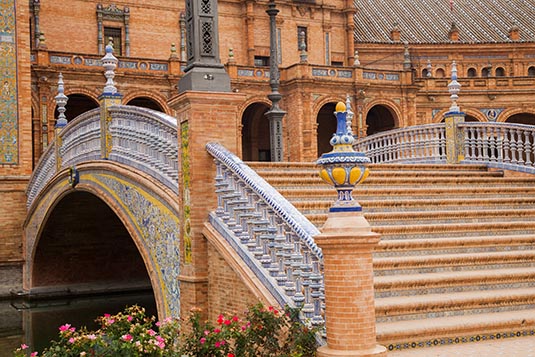 The years of highest splendour in Seville happened after the discovery of America. During the 16th and 17th century its port was one of the most important in Spain, because it had the monopoly of the foreign trade by sea. Thanks to the trade carried out during that period in Seville, many mansions, stately homes, churches and convents were built. 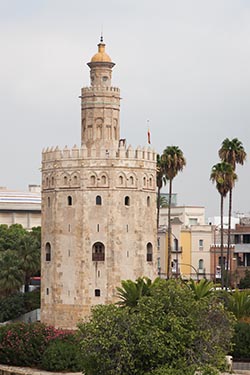 The city of Seville is situated in the fertile valley of the Guadalquivir River. The river bisects the city in two. Most of the city is on the eastern side with neighbourhoods of Macarena and Arenal whilst on the western side is Triana.
The city of Seville is situated in the fertile valley of the Guadalquivir River. The river bisects the city in two. Most of the city is on the eastern side with neighbourhoods of Macarena and Arenal whilst on the western side is Triana.
Many civilisations have come and gone in the city of Seville. The Tartessians founded Hispalis, and the Romans built the famous Italica next to it in 207 BC. Founded by General Scipio, two Roman emperors were born there: Trajan and Adrian. The long presence of the Moors, from 711 to 1248 AD, left permanent imprints on the city. The end of the Caliphate of Cordoba (11th century) brought about the splendour of the Taifa Kingdom of Seville, especially under the reign of al-Mutamid, the poet king. We reached Seville early evening from Algarve, Portugal. We were two couples on a holiday to Portugal and Spain. For this leg, we had hired a van. Post breakfast we left our hotel. The drive to Seville was about 2 hours. Enroute we took a halt near the border of Portugal and Spain for a quick bite and some souvenir shopping. 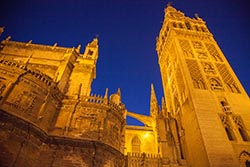 We would spend 2 nights in Seville. The hotel for our stay was Gran Melia Colon. It was located downtown with walking distance to De La Constitucion Avenue, Cathedral and the Palace complex. Luckily for us, that evening there was a Flamenco show for hotel guests. Coming to Spain and going back without seeing the Flamenco is surely not a good idea.
We would spend 2 nights in Seville. The hotel for our stay was Gran Melia Colon. It was located downtown with walking distance to De La Constitucion Avenue, Cathedral and the Palace complex. Luckily for us, that evening there was a Flamenco show for hotel guests. Coming to Spain and going back without seeing the Flamenco is surely not a good idea.
Flamenco is a Spanish art form made up of three parts: guitar playing ("guitarra"), song ("cante"), and dance ("baile"). Flamenco originated in the southern regions of Spain, but it's thought to be influenced by many world cultures, including Latin American, Cuban, and Jewish traditions. Although many of the details of the development of Flamenco are lost in history, it is certain that it originated in Andalusia and that from the VIII to the XV centuries, when Spain was under Arab domination, their music and musical instruments were modified and adapted by Christians and Jews, and later by gypsies. 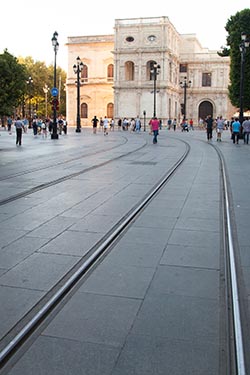 Soon after check-in we were ready to walk the town. A leisurely walk through Plaza Nueva and Plaza De San Francisco got us on the magnificent Av De La Constitucion. Further up standing proud was Seville Cathedral.
Soon after check-in we were ready to walk the town. A leisurely walk through Plaza Nueva and Plaza De San Francisco got us on the magnificent Av De La Constitucion. Further up standing proud was Seville Cathedral.
The cathedral stands on the site of what was –in the 12th century– the Great Mosque. Today, the only part which remains of this structure is the minaret, also known as the Giralda due to the weather vane added to the top in the 16th century. The Abluciones courtyard and today's Puerta del Perdon door are also parts of the old mosque. It was converted into a Christian church when the city was conquered by Ferdinand III of Castile in 1248. Several stages of building can be seen, with examples of the Mudejar, Gothic, Renaissance, Baroque and Neo-classical styles. Access to the cathedral is through the Plaza Virgen de los Reyes square. It has five naves (the main nave has a height of 36 metres) and a rectangular floor plan, measuring 116 metres long and 76 metres wide. The transept rises to a maximum height of 40 metres. The main altarpiece was built over a series of different periods, and includes pieces by the brothers Jorge Fernandez Aleman and Alejo Fernandez, Roque Balduque, Pedro Millan, Juan Bautista Vazquez the Elder and Pedro de Heredia. The Renaissance-style chapter room dates from the second half of the 16th century. The main sacristy is Plateresque. The tomb of Christopher Columbus lies in the cathedral. 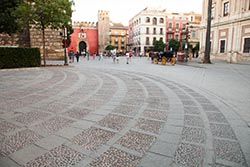 Just behind the cathedral is Plaza de Triunto. From this square one gets access to the Giralda as well as Reales Alcazares (Royal Palace).
Just behind the cathedral is Plaza de Triunto. From this square one gets access to the Giralda as well as Reales Alcazares (Royal Palace).
The Giralda is the bell tower of the Seville Cathedral. It was originally built as a minaret during the Moorish period, with a Renaissance style top subsequently added by Spaniards. The tower is 104 metres in height and remains one of the most important symbols of the city, as it has been since medieval times. The Royal Palace was originally developed by Moorish Muslim kings. The palace is renowned as one of the most beautiful in Spain, being regarded as one of the most outstanding examples of Mudejar architecture found on the Iberian Peninsula. The upper levels of the Alcazar are still used by the royal family as the official Seville residence and are administered by the Patrimonio Nacional. There was a long line of tourists to get into the palace. Sadly, we gave it a miss. We were later told, that the interiors of the palace were well worth a visit. 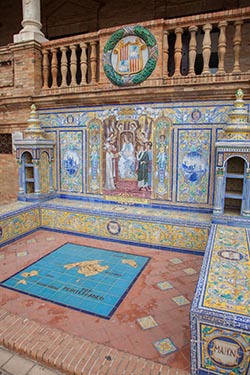 Moving around in horse-driven carriages is indeed a royal (and romantic) way of exploring this part of Seville. The carriage can comfortably seat 4 and costs about Euro 90 for an hour's ride. Yes, it was rather steep, but then you don't go to Seville every day! We opted for the ride.
Moving around in horse-driven carriages is indeed a royal (and romantic) way of exploring this part of Seville. The carriage can comfortably seat 4 and costs about Euro 90 for an hour's ride. Yes, it was rather steep, but then you don't go to Seville every day! We opted for the ride.
The tour winds through the old streets, going through Torre del Oro, the Plaza de Espana and Parque Marie Louisa before finishing back in the old city. The Torre del Oro or the Tower of Gold, is a dodecagonal military watchtower on the banks of the river. It was erected by the Almohad Caliphate in order to control access to Seville via the Guadalquivir River. Constructed in the first third of the 13th century, the tower served as a prison during the Middle Ages. Its name comes from the golden shine it projected on the river, due to its building materials (a mixture of mortar, lime and pressed hay). The tower is divided into three levels, with the third and uppermost being circular in shape and added in 1769. The Torre de la Plata, an octagonal tower, is located nearby, and is believed to have been constructed during the same era. 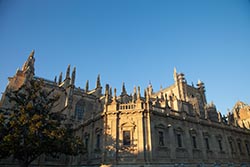 Plaza de Espana is indeed a cultural meeting place. Painted ceramic benches representing all the provinces in Spain are arranged round the square. It was built because of the Ibero-American Exhibition of 1929, held in Seville. Its creator was Anibal Gonzalez. He mixed a style inspired by the Renaissance with typical elements from the city: exposed brick, ceramics and wrought iron (worked by Domingo Prida). Its floor plan is semicircular. It is dominated by 2 towers, one on each side of the enclosed area, which frame the central building where the main rooms are. Between the two towers runs a network of galleries with an arcade of semicircular arches leading to exits in different parts of the square, where a fountain stands. There is a moat that has four bridges across it. Today, the building houses various Government offices.
Plaza de Espana is indeed a cultural meeting place. Painted ceramic benches representing all the provinces in Spain are arranged round the square. It was built because of the Ibero-American Exhibition of 1929, held in Seville. Its creator was Anibal Gonzalez. He mixed a style inspired by the Renaissance with typical elements from the city: exposed brick, ceramics and wrought iron (worked by Domingo Prida). Its floor plan is semicircular. It is dominated by 2 towers, one on each side of the enclosed area, which frame the central building where the main rooms are. Between the two towers runs a network of galleries with an arcade of semicircular arches leading to exits in different parts of the square, where a fountain stands. There is a moat that has four bridges across it. Today, the building houses various Government offices.
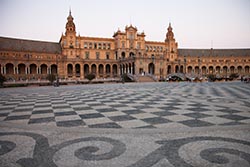 The Maria Luisa Park is the largest park in Seville and one of the most beautiful in Europe. It has a very interesting history. Maria Luisa Fernanda was the younger sister of Queen Isabella II during the 19th century. She lived between 1832 and 1897. She was the youngest daughter of King Ferdinand VII of Spain. After Maria Luisa Fernanda died in 1897, she was buried at El Escorial. However, the city of Seville did not take the gardens under their management until the Iberoamerican Exhibition. Before the 1929 Iberoamerican Exposition, the city of Seville hired the famous French landscape architect Nicolas Forestier to redesign the gardens, now named after Maria Luisa Fernanda. Forestier was the landscape architect who designed the Bois de Boulogne in Paris.
The Maria Luisa Park is the largest park in Seville and one of the most beautiful in Europe. It has a very interesting history. Maria Luisa Fernanda was the younger sister of Queen Isabella II during the 19th century. She lived between 1832 and 1897. She was the youngest daughter of King Ferdinand VII of Spain. After Maria Luisa Fernanda died in 1897, she was buried at El Escorial. However, the city of Seville did not take the gardens under their management until the Iberoamerican Exhibition. Before the 1929 Iberoamerican Exposition, the city of Seville hired the famous French landscape architect Nicolas Forestier to redesign the gardens, now named after Maria Luisa Fernanda. Forestier was the landscape architect who designed the Bois de Boulogne in Paris.
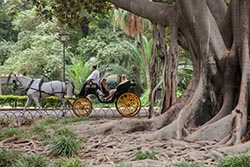 While one side of the park has the Plaza de Espana, at another side of the park is the Plaza de America, which is also called the Plaza de las Palomas (Plaza of the Doves) because of the many doves that live there. It has many fountains, ponds, and gardens. There is a beautiful Mudejar building called the Pabellon Mudejar, which contains the Museum of Popular Arts and Customs. Across from it is a neo-Renaissance building, which now contains the Archaeological Museum, famous for its Roman statues and remains from Italica, the museum being one of the best in the country. The museum also has the Phoenician statue of Astarte-Tanit, the virgin goddess. The plaza’s gardens have palm trees and roses.
While one side of the park has the Plaza de Espana, at another side of the park is the Plaza de America, which is also called the Plaza de las Palomas (Plaza of the Doves) because of the many doves that live there. It has many fountains, ponds, and gardens. There is a beautiful Mudejar building called the Pabellon Mudejar, which contains the Museum of Popular Arts and Customs. Across from it is a neo-Renaissance building, which now contains the Archaeological Museum, famous for its Roman statues and remains from Italica, the museum being one of the best in the country. The museum also has the Phoenician statue of Astarte-Tanit, the virgin goddess. The plaza’s gardens have palm trees and roses.
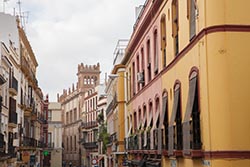 By the time we were back at the Plaza de Triunto from our trot, it was late evening and the place had lit up. We had tapas in one of the restaurants across the Giralda. Post dinner, we walked back to our hotel. At 10 PM the Flamenco show was scheduled. We enjoyed the 3-artist troupe and rested for the night.
By the time we were back at the Plaza de Triunto from our trot, it was late evening and the place had lit up. We had tapas in one of the restaurants across the Giralda. Post dinner, we walked back to our hotel. At 10 PM the Flamenco show was scheduled. We enjoyed the 3-artist troupe and rested for the night.
Tomorrow morning we had plans to take the hop-on-hop-off bus for a half day drive through the city. And in the afternoon to visit Sevilla- The Style Outlets to shop! Post breakfast we took a cab to drop us at Plaza de Espana. Though we had a glimpse of this fantastic monument, we wanted to soak it in a bit more. The plan was to explore the plaza and the adjoining Maria Luisa Garden and then hop on the bus to tour the city. 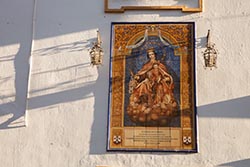 Things worked as per plans. In about 90-minutes we were on board City Sight Seeing Seville Hop On Hop Off bus. There are 13 stops on this tour that cover both sides of the river. Major attractions along the route were our boarding point Plaze de Espana, Noria de Seville (has a ferry’s wheel on banks of the river), Torre del Oro, Basilica de El Cachorro (in Triana), Pavilion of Navigation, Monastery of the Cartuja, Expo 92 area, Isla Magica, Torre de los Perdigones, Macarena and ending at Plaza del Duque.
Things worked as per plans. In about 90-minutes we were on board City Sight Seeing Seville Hop On Hop Off bus. There are 13 stops on this tour that cover both sides of the river. Major attractions along the route were our boarding point Plaze de Espana, Noria de Seville (has a ferry’s wheel on banks of the river), Torre del Oro, Basilica de El Cachorro (in Triana), Pavilion of Navigation, Monastery of the Cartuja, Expo 92 area, Isla Magica, Torre de los Perdigones, Macarena and ending at Plaza del Duque.
From the Plaza del Duque we took a taxi to reach The Style Outlets. The outlet is located near the airport on the outskirts of the city. Till 9 PM that evening we were at the outlet. Since we had females in the group, shopping happened to our heart’s content. With pockets empty, we took a cab back (you would need to wait for at least 20 minutes after calling them from the information counter) to our hotel. The next morning we would proceed to Marbella with de-tour to Gibraltar. Seville Image Gallery  Photo viewer Photo viewer
|
|
|
Home |
Charity |
Feedback
Privacy Policy | Terms of Usage © YoGoYo.com. All rights reserved. |





















































